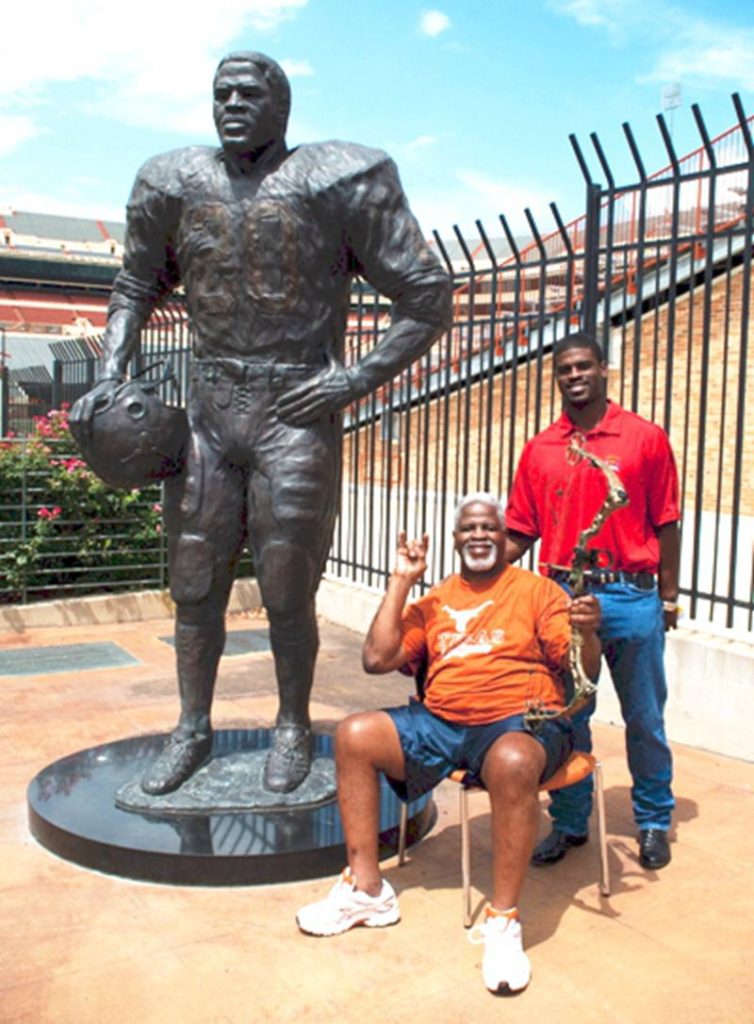
The Texas Longhorns are set to honor one of the most iconic figures in their football history, Earl Campbell, with a statue at Darrell K. Royal-Texas Memorial Stadium. The decision to erect this statue is a monumental moment for the Longhorns’ community and reflects not only Campbell’s contributions to the university but also his enduring legacy as one of college football’s most revered athletes. This decision resonates deeply within the hearts of fans, former players, and coaches, reinforcing the fact that Earl Campbell’s impact extends far beyond the football field. In this article, we will explore the immense legacy of Earl Campbell, the significance of this tribute, and why it’s the perfect way to celebrate a player who helped define the Texas Longhorns program.
Earl Campbell’s journey to greatness began in Tyler, Texas, where he was born on March 29, 1955. Raised in a working-class family, Campbell was no stranger to hard work and determination. From an early age, he demonstrated an extraordinary aptitude for football. His high school career at John Tyler High School in his hometown was nothing short of spectacular, earning him a reputation as one of the top running back prospects in the state of Texas. Campbell’s raw talent and drive were evident, and it didn’t take long for scouts to take notice.
After an outstanding high school career, Campbell committed to the University of Texas, where his journey to becoming a Longhorn legend would truly begin. In 1974, Campbell joined the Texas Longhorns football program, then led by legendary head coach Darrell K. Royal. Although it wasn’t an immediate starting role, Campbell’s potential quickly became apparent. The coaches were impressed by his combination of speed, power, and vision, and by the time he was a sophomore, Campbell was firmly entrenched as the Longhorns’ starting running back.
During his time in Austin, Campbell redefined the position of running back. His ability to break tackles with sheer power, combined with his surprising agility for a player of his size, made him nearly unstoppable. But it wasn’t just his physical attributes that made him stand out; it was his heart, determination, and love for the game that set him apart from his peers. Earl Campbell wasn’t just a football player—he was a force of nature, a symbol of what it meant to be a Texas Longhorn.
Earl Campbell’s time at the University of Texas is one of the most decorated in the history of the program. He played for the Longhorns from 1974 to 1977, and during that period, he left an indelible mark on both the university and the sport of college football. His career achievements and individual accolades speak for themselves.
In his freshman season, Campbell demonstrated flashes of brilliance. He rushed for 872 yards and scored 10 touchdowns, establishing himself as a key contributor to the Longhorns’ offensive attack. But it was in his sophomore year when Campbell truly burst onto the national scene. In 1975, Campbell rushed for 1,117 yards and 12 touchdowns, helping lead Texas to a 10-1 record and a victory in the Cotton Bowl.
The 1977 season would be the crowning achievement of Campbell’s college career. That year, he led the Longhorns to a Southwest Conference title and a berth in the Cotton Bowl. Campbell rushed for 1,744 yards and 19 touchdowns that season, earning him the prestigious Heisman Trophy as the best player in college football. His Heisman victory was not only a personal achievement but also a triumph for the University of Texas, as Campbell became the first Longhorn to win the prestigious award.
Beyond the statistics and accolades, Campbell’s impact on the Longhorns was immeasurable. He brought excitement, passion, and a relentless work ethic to every game he played, becoming a beloved figure in the Texas football community. His fierce running style, combined with his leadership on and off the field, made him a role model for future generations of Longhorns. His legacy at Texas wasn’t just about the records he set—it was about the standard of excellence he established.
After an illustrious career at the University of Texas, Campbell was selected as the first overall pick in the 1978 NFL Draft by the Houston Oilers. His transition to the NFL was as seamless as his move to college football. In his rookie season, Campbell made an immediate impact, rushing for 1,450 yards and 13 touchdowns. His performance earned him the NFL Offensive Rookie of the Year award, and it was clear that Earl Campbell was a special talent.
Over the course of his NFL career, Campbell continued to dominate. He played for the Oilers for most of his career, later spending a brief stint with the New Orleans Saints. His running style—powerful, punishing, and relentless—was perfect for the grind of professional football. He became one of the league’s top rushers, earning five Pro Bowl selections and winning the NFL MVP award in 1979.
Campbell’s most remarkable achievement in the NFL came in 1979 when he helped lead the Oilers to the AFC Championship Game. He finished the season with 1,697 rushing yards and 19 touchdowns, further solidifying his place among the NFL’s elite. His ability to break tackles and bulldoze through defenders made him one of the most feared running backs in NFL history.
By the time Campbell retired from the NFL in 1985, he had cemented his place as one of the best running backs of his era. His career statistics—9,407 rushing yards and 74 touchdowns—remain a testament to his brilliance on the field. While injuries eventually took their toll, Campbell’s legacy as one of the most dynamic and dominant running backs in the history of the sport was forever secure.
Erecting a statue of Earl Campbell at Darrell K. Royal-Texas Memorial Stadium is more than just a way to commemorate a player; it’s a way to honor a legacy that transcends the sport of football. For the Longhorns, Campbell is not only a football hero but also a symbol of the university’s excellence, toughness, and tradition. The statue will serve as a reminder to future generations of students, athletes, and fans about the power of hard work, dedication, and the pursuit of greatness.
The decision to place the statue at Darrell K. Royal-Texas Memorial Stadium—the home of Texas Longhorns football—underscores the significance of Campbell’s connection to the university. It’s a fitting tribute to a player whose accomplishments helped shape the identity of the Longhorns program and who was the embodiment of what it means to be a Texas Longhorn. For fans, the statue will provide a permanent, tangible reminder of Campbell’s greatness and the memories he created during his time at the university.
Earl Campbell’s impact extends far beyond his playing days, and his contributions to the Texas Longhorns and the sport of football are felt even today. After retiring from the NFL, Campbell became an advocate for the sport and a philanthropist in the Houston area. His work with various charitable organizations, including those focused on youth development and education, further underscores his commitment to making a positive impact in his community.
Additionally, Campbell’s legacy as a trailblazer for African-American athletes in football cannot be overstated. As a player who broke down barriers and overcame adversity, Campbell served as an inspiration for countless young athletes who followed in his footsteps. His success on the field, paired with his leadership off the field, has made him an enduring role model for future generations of players.
The statue at Darrell K. Royal-Texas Memorial Stadium will not only honor Earl Campbell’s football career but also celebrate the man he became. His legacy is defined not just by his extraordinary athleticism but also by his character, humility, and dedication to others. Earl Campbell’s contributions to the University of Texas and the state of Texas will never be forgotten, and the statue will serve as a fitting tribute to a man who has given so much to both.
The announcement that a statue of Earl Campbell will be erected at Darrell K. Royal-Texas Memorial Stadium is a momentous occasion for the University of Texas, its football program, and its fans. Earl Campbell’s impact on the Longhorns and the sport of football is immeasurable, and this statue will stand as a testament to his greatness for generations to come.
From his record-breaking college career to his legendary days in the NFL, Earl Campbell’s journey is one of hard work, perseverance, and excellence. His legacy goes beyond football; he is a symbol of what it means to represent the University of Texas with pride, passion, and dedication. The statue will forever remind us of the extraordinary athlete, leader, and person that Earl Campbell was—and continues to be. As Longhorns fans gather at the stadium in the future, they will be able to reflect on the legacy of a true Texas icon, and in doing so, they will honor the memory of one of the greatest to ever wear the burnt orange and white.





